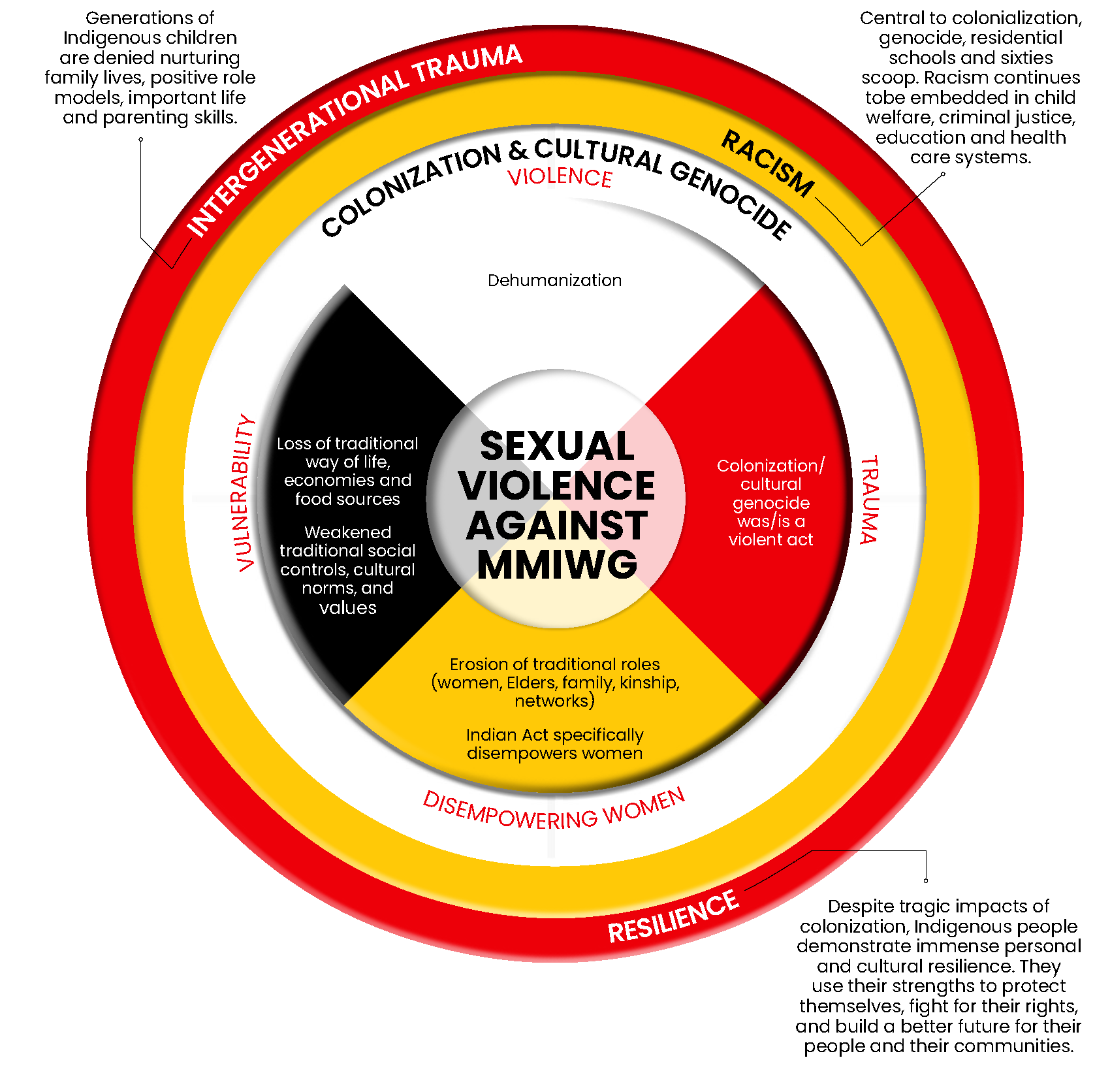Understanding the Root Causes of Sexual Violence
Inner Circle
Sexual Violence
“For many years government policy has left many Indigenous families and communities broken apart and impoverished therefore resulting in the vulnerability of many Indigenous women and girls to exploitation and attack.”
-Violence Against Indigenous Women and Girls in Canada, Amnesty International
Indigenous people, and specifically women and girls, face disproportionately high rates violence, including sexual violence. Indigenous women are three times more likely than non-Indigenous women to be the victim/survivor of violent crime.
Missing and Murdered Indigenous Women and Girls (MMIWG)
Thousands of Indigenous women have gone missing or been murdered in this country, including in Nova Scotia, in the last few decades. Police have recorded 1800 missing or murdered women and girls. Estimates by families, Indigenous groups, and the federal government are much higher.
Second Circle
Colonization and Cultural Genocide
It is important to look at this violence in the context of colonialism, cultural genocide, racism, and intergenerational trauma, which have left Indigenous people, and women, girls and Two Spirit people specifically, vulnerable to sexual violence.
Colonization brought with it many values and belief systems, followed by policies and laws, that were in opposition to Indigenous values, cultural norms, and social controls (expectations regarding behaviors enforced by the group). Pre-contact Mi’kmaw people prevented and dealt with violence by utilizing these social controls, including public shaming.
Colonization and cultural genocide continue today.
Some of the impacts of colonization and cultural genocide include:
Dehumanization (thinking of a person or a group of people as less than human)
- Treating Indigenous people inhumanely/violence against Indigenous people.
- Treating an entire population of diverse and multifaceted women as sex objects, making them vulnerable to sexual violence.
- Inadequate police investigation if an Indigenous woman is subjected to violence and/or goes missing.
Robbing people of their traditional way of life, spirituality, economies, and food sources
- Lack of control of natural resources.
- High rates of poverty.
- Lack of housing options/poor living conditions, on and off reserve.
- Poor health due to lack of traditional foods.
- Lack of traditional coping mechanisms/supports/ways of healing.
Imposing European gender roles and binaries
- Undermined traditional division of responsibilities/labour, introduced gendered hierarchy.
- Imposed sexist ideas about women.
- Targeted women (often via children) in attempt to destroy culture.
- Undermined Two-Spirit identity and role of Two-Spirit people in communities.
Disrupting the roles, values, and traditions of Indigenous families and communities
- Robbed women of traditional roles, such as maintaining social controls and passing down language.
- Undermined traditional roles of family and kinship networks.
- Imposed child protection, disproportionate rate of Indigenous children in care, insufficient funding for on-reserve services.
- Broke up families and denied Indigenous children cultural identity.
- Negatively impacted mental health, and lead to trauma, alcohol and drug abuse, and a high number of youth suicides.
Reflection Activity:
Reflection: How do the impacts of colonization and cultural genocide make Indigenous women and girls more vulnerable to sexual violence? Add your thoughts to your notes using the button.
Third Circle
Racism
- Linked to dehumanization.
- Uneven access to power leading to inequality (systemic racism).
- Central to colonization, cultural genocide, residential schools, the 60’s scoop, disproportionate numbers of children in care, and high rates of incarceration.
Reflection Activity:
Reflection: How does the racism present in our education, child welfare, and criminal justice systems contribute to the high rates of sexual violence against Indigenous people, and women and girls specifically?
How might racism in the health care system impact the kind of support a victim/survivor seeks or receives? Add your thoughts to your notes using the button.
Fourth Circle
Intergenerational trauma
Intergenerational trauma is widespread in Indigenous communities and stems from traumatic experiences such as residential schools, the 60's scoop, the mass incarceration of Indigenous people, or being a surviving family member of a missing or murdered Indigenous woman or girl. Intergenerational trauma can be the result of a constant feeling or loss or grief experienced by some Indigenous people.
Many Indigenous trauma survivors did not or have not had the opportunity to address their trauma. For example, residential school students were denied access to families, Elders, and communities who could have helped them to deal with the physical, mental, emotional, and spiritual impacts of trauma.
These traumatic events impacted entire generations, including generations of Elders who would traditionally provide cultural and spiritual support and guidance. Additionally, many residential school and 60's scoop survivors weren’t able to talk about their experiences until recently.
Reflection Activity:
Reflection: What are some examples of ways in which intergenerational trauma impacts Indigenous children and youth today?Add your thoughts to your notes using the button.
Fifth Circle
Resilience
“Despite the many layers of trauma experienced by Aboriginal peoples throughout history and into today, Aboriginal women, men, their families and communities, continue to live and love, work, teach, protect, provide, hope, create and dream. It is a legacy of strength and resilience, one more powerful than colonialism.”
- What Their Stories Tell Us: Research findings from the Sisters In Spirit initiative, Native Women’s Association of Canada (NWAC)
Visit Mi’kmaq Culture and Resilience for more information.
Reflection Activity:
Reflection: How is cultural resilience a protective factor against sexual violence? Add your thoughts to your notes using the button.
